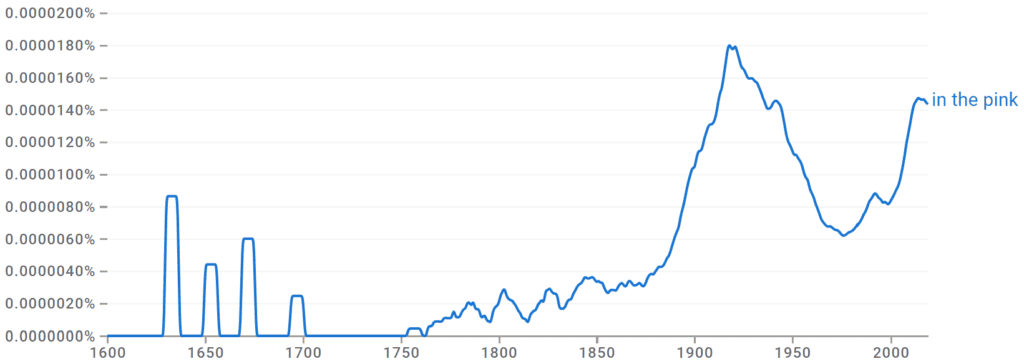In the pink is an idiom that means the very excellence of something and is commonly used in reference to health. For example, if you are impressed with the agility of your elderly dog, you might say, “A careful diet and regular exercise have helped keep him in the pink of health despite his age.”
Idioms are words and phrases used in a figurative manner unrelated to their literal origins. They help make connections to an author’s message and add detail to elevate a mastery of the English language.
To learn more about the interesting origins of the idiomatic phrase and explore its meaning and usage in various examples, keep reading!

In the Pink Meaning Explained
In the pink is an English idiom that means to be at the peak of health, or for something to be in perfect or near perfect condition. Its use is synonymous with being the highest level of excellence in anything it references.
For example:
- As a world-renowned artist, he has every reason to be in the pink.
- She was in the pink of her career during the 1930s.
- My father is in the absolute pink of health for his age.
In the Pink Origins

There is quite an etymological history surrounding the word pink. Long before pink was associated with a color, it was the common name of the Dianthus plant during the 16th century. The name likely came about due to its scalloped petals, which mimicked the practice of “pinking” or decorating a garment with small holes in patterns along the edge from around 1500. In fact, this name still exists in the modern term “pinking sheer” or fine scissors used by seamstresses.
Pink is also a Dutch term from the term pinck oogen which means “half-closed eyes or small eyes,” as the Dianthus also has small dots that resemble eyes.
Another possible explanation and relationship to the word is the French piquer, meaning “to prick or pierce.” Piquer comes from the 13th-century Latin pungde, which described “the stabbing with a pointed weapon.” To pink a person meant to draw first blood when fencing. Many Dianthus have a darker hue or red outline, as if “pinked” or punctured to draw blood.
You’re probably wondering what this has to do with the figurative use of the word, but knowing what a pink was and how it came about is important in understanding its significance in relation to anything of the highest standard.
No matter whether the word pink was associated with one or all of the above theories, the Dianthus flower, or Pink as it was called, was a favorite of Queen Elizabeth I. During her reign, it was well known she admired the cheerful blooms, and the term “in the pink” was first associated with figurative excellence at this time. This association came to be due to the time period’s history of adopting anything the monarch preferred as a mode of popularity.
The earliest example of this is from 1597 in Shakespeare’s “Romeo & Juliet” when Mercurio states, “Why, I am the very pinke of curtesie.”
It is again seen through the centuries, all used to draw attention to excellence in whatever it is referring to. For example, in Leigh’s “Kensington Gardens” (1720):
‘Tis the Pink of the Mode, to marry at first Sight: – And some, indeed, marry without any Sight at all.
In reference to the excellence of fashion, it became commonly used in the 19th century as seen in “The Cornhill Magazine” by Thackeray:
In the very pink of the mode.
Even Charles Dickens, in his letters written in 1845, uses the term to describe the absolute “most” of something miserable:
Of all the picturesque abominations in the World, commend me to Fondi. It is the very pink of hideousness and squalid misery.
By the early 1900s, a “pink of condition” is seen used in the “Kynoch Journal Concerning Guns and Ammunition”:
Makers may despatch explosives from the factory in the pink of condition.
Let’s Review
In the pink is an idiom rooted in the allure of the Dianthus plant, particularly cherished by Queen Elizabeth I. Given the trend during her era to emulate anything favored by royalty, the term “pink” and eventually “in the pink” evolved to symbolize the pinnacle of excellence. This colorful expression, which dates back to the times of Shakespeare, has remarkably retained its meaning throughout the centuries. So, when we say something is “in the pink,” we’re harking back to an age-old tradition of celebrating the very best of the best.
Want more idioms in your arsenal? Check out some others we covered:
